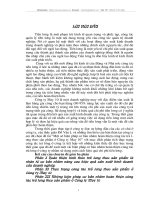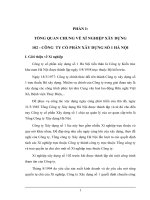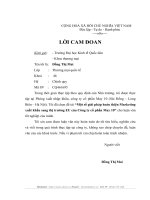adj 10
Bạn đang xem bản rút gọn của tài liệu. Xem và tải ngay bản đầy đủ của tài liệu tại đây (136.58 KB, 16 trang )
<span class='text_page_counter'>(1)</span>Adjectives To talk or write about a person place or thin. g, you use nouns like girl, house,or tree. To add descriptions to those nouns that give th e reader a clearer picture of what you mean, you add “detail” words in front of the noun lik e little, blue, rich, old. Words that tell more a bout nouns or pronouns are called adjective s..
<span class='text_page_counter'>(2)</span> Classification of Adjectives one-word adjective--compound adjective dynamic adjective: tall, short, big, small, ugly. , beautiful, shallow, deep, blue, white static adjective: abusive, ambitious, awkwar d, brave, calm, careful, dull, enthusiastic, ext ravagant, faithful, reasonable, rude, thoughtf ul, troublesome, vain, vicious, wicked, witty.
<span class='text_page_counter'>(3)</span>
<span class='text_page_counter'>(4)</span> Attributive and predicative adjecti ves “Attributive” and “predicative” are terms use. d in grammar to indicate the position of an a djective in a noun phrase. An attributive adje ctive is one that premodifies a noun (as in “t he beautiful girl”). A predicative adjective is one that is used as postmodifier of a noun (“the stars visible”)..
<span class='text_page_counter'>(5)</span> Attributive and predicative adjecti ves Attributive adjectives are associated with "p. ermanence", they state -in general- a perma nent quality or state of the noun they modify. Predicative adjectives are associated with "t emporariness", as in the example "the stars visible", which refers to the stars you can se e at a specific time or under specific circums tances. Not all the stars are visible all the ti me..
<span class='text_page_counter'>(6)</span> Attributive and predicative adjecti ves there are a few general descriptive adjective. s which cannot be used as predicate adjecti ves. For example, the adjectives listed belo w are normally used only as attributive adjec tives. chief, main, principal, sheer, utter.
<span class='text_page_counter'>(7)</span> Usual Order of Attributive Adjectiv es a) adjectives indicating size e.g. large, long, narrow. b) adjectives indicating weight e.g. heavy, light c) participles and other adjectives e.g. clever, excited , interesting d) adjectives indicating temperature e.g. cold, hot, w arm e) adjectives indicating humidity e.g. dry, damp, wet.
<span class='text_page_counter'>(8)</span> Usual Order of Attributive Adjectiv es f) adjectives indicating age e.g. new, six-mont h-old, young g) adjectives indicating shape e.g. barrel-shap ed, round, square h) adjectives indicating color e.g. blue, grey, w hite i) adjectives indicating materials e.g. cloth, lea ther, metal.
<span class='text_page_counter'>(9)</span> Usual Order of Attributive Adjectiv es j) defining adjectives, usually indicating purpos e, method of operation, location, time or cat egories of people e.g. a small, heavy, snug, warm, 100-year-ol d, round-bellied black iron Norwegian wood stove.
<span class='text_page_counter'>(10)</span> Predicate adjectives Adjectives which can be used only as predicat. e adjectives The following are examples of adjectives with the prefix a- which can be used only as predicate adje ctives, not as attributive adjectives. The prefix a- w as formerly a preposition meaning on. afloat, afraid, aglow, alive, alone, asleep.
<span class='text_page_counter'>(11)</span> Gradable and Non-gradable adjectiv es gradable adjective. tall---taller---tallest beautiful---more beautiful---most beautiful Non-gradable adjective: atomic scientist, hydr ochloric acid, French food, Chinese carpet, perfect , excellent, extreme.
<span class='text_page_counter'>(12)</span> Degrees of Adjectives As well as being used to describe persons. and things, adjectives which refer to qualities can also be used to compare two or more different persons or things. For instance, in the following sentences. He is as tall as his brother. She is older than her sister. They are the youngest students in the class..
<span class='text_page_counter'>(13)</span> Degrees of Adjectives Positive degree: the base form of the adj. ective or adverb. It does not show compa rison. Comparative degree: the form an adjectiv e or adverb takes to compare two things. Superlative degree: the form an adjective or adverb takes to compare three or mor e things..
<span class='text_page_counter'>(14)</span> Positive forms of adjectives prece ded and followed by As This type of construction can be used to indi. cate that the things being compared are equ al in some respect. Swans are as white as snow. The meaning of an expression using as, foll owed by an adjective, followed by as can be qualified by adverbs such as not, almost, t wice, three times, half, one-third and so o n..
<span class='text_page_counter'>(15)</span> “More…than” construction Basic pattern: “comparative degree + than-clause” Eg. This parcel is heavier than that one. Another pattern : “determiner more /less /fewer + n. oun + than-clause” Eg. I have done more work than he. A variant form pattern: “compatative adjective + no un + than-clause” Eg. John is a more efficient worker than Jack..
<span class='text_page_counter'>(16)</span> “(The)+ superlative adjective / adverb + scope of comparison ” Contrast between comparative constructions 1) “More…than” vs quasi-coordinative type 2) “Not so…as”vs “not so much…as” 3) “Not more/ -er…than”vs “no more/-er…th. an” 4) “The more …the more”vs “more and mor e”.
<span class='text_page_counter'>(17)</span>





![SECTION 10: FOUNDATIONS TABLE OF CONTENTS [TO BE FURNISHED WHEN SECTION IS FINALIZED]](https://media.store123doc.com/images/document/12/pt/qq/medium_dY8TJTm9cv.jpg)


